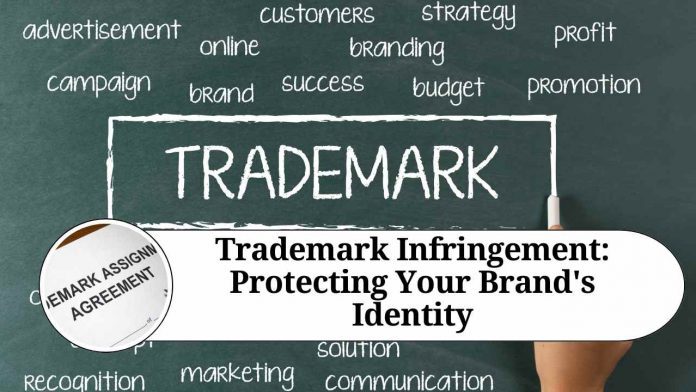Introduction
In today’s highly competitive business world, building a strong brand identity is crucial for success. A trademark serves as a valuable asset for businesses, representing their products or services and distinguishing them from competitors. However, the unauthorized use or infringement of a trademark can have severe consequences for both the brand owner and the infringer. In this blog post, we will explore the concept of trademark infringement, its implications, and the steps businesses can take to protect their valuable intellectual property.
Understanding Trademark Infringement
Trademark infringement occurs when a person or entity uses a trademark or a similar mark that is likely to cause confusion among consumers. This unauthorized use can dilute the distinctiveness of the original mark or lead to a loss of brand reputation and customer trust. Infringement can take various forms, including using an identical mark, a similar mark, or a mark that is likely to create confusion with the original trademark.
Implications of Trademark Infringement
Trademark infringement can have significant consequences for both the brand owner and the infringing party. Let’s take a closer look at these implications:
- Damage to Brand Reputation: Unauthorized use of a trademark can confuse consumers, leading them to associate the infringing products or services with the original brand. This can damage the brand’s reputation, erode customer trust, and affect its market position.
- Loss of Sales and Profits: Trademark infringement often leads to a loss of sales and profits for the brand owner. The infringer may benefit from the established reputation and goodwill associated with the original mark, diverting customers and potential business opportunities.
- Legal Consequences: Trademark owners have the right to take legal action against infringers. Depending on the jurisdiction, the brand owner can seek remedies such as injunctions, damages, account of profits, or even criminal penalties in extreme cases.
Protecting Your Trademark
To safeguard your trademark and prevent infringement, consider the following proactive measures:
- Register Your Trademark: Registering your trademark provides legal protection and establishes your exclusive rights to the mark. It is advisable to conduct a thorough search to ensure that your chosen mark is unique and does not infringe upon existing trademarks.
- Monitor and Enforce: Regularly monitor the market and online platforms to detect any unauthorized use of your trademark. Enforce your rights promptly by sending cease and desist letters or taking legal action when necessary.
- Educate Employees and Partners: Ensure that your employees, partners, and stakeholders are aware of your trademark and its proper usage. Educate them about the importance of protecting the brand’s identity and the potential consequences of infringement.
- Police Online Presence: With the increasing prevalence of online commerce, monitoring your trademark’s use on websites, social media platforms, and online marketplaces is crucial. Act swiftly to address any infringement found in these digital spaces.
- Consult Legal Experts: Working with intellectual property attorneys or legal professionals who specialize in trademark law can provide valuable guidance throughout the registration process, as well as in case of infringement disputes.
Conclusion
Trademark infringement poses a significant risk to a brand’s identity, reputation, and market position. By understanding the concept of trademark infringement and taking proactive measures to protect your brand, you can minimize the potential risks and safeguard your valuable intellectual property. Registering your trademark, monitoring the market, enforcing your rights, and seeking legal advice when needed are essential steps to ensure the long-term success and integrity of your brand in today’s competitive business landscape.
Other Related Blogs: Section 144B Income Tax Act
Frequently Asked Questions (FAQs)
Q. What is trademark infringement?
Trademark infringement refers to the unauthorized use of a trademark or a similar mark that may cause confusion among consumers. It occurs when another party uses a mark that is identical or similar to an existing registered trademark, potentially leading to a dilution of the original mark’s distinctiveness or causing consumer confusion.
Q. How can I determine if someone is infringing on my trademark?
To determine if someone is infringing on your trademark, you should monitor the marketplace, including online platforms and physical stores, for any unauthorized use of your mark. Conduct regular searches to identify potential infringers. Look for marks that are similar or identical to your trademark and assess whether they are used in connection with similar products or services. If you discover any potential infringements, consult with a trademark attorney for a professional evaluation.
Q. What should I do if I suspect trademark infringement?
If you suspect trademark infringement, it is advisable to take the following steps:
Gather evidence: Collect any evidence that demonstrates the unauthorized use of your trademark, such as photographs, product samples, advertisements, or website screenshots.
Consult with an attorney: Seek legal advice from a trademark attorney who can guide you through the process of addressing the infringement and protecting your rights.
Send a cease and desist letter: Your attorney can help you draft and send a cease and desist letter to the infringing party, demanding that they stop using your trademark and possibly seek compensation for damages.
Consider legal action: If the infringer does not comply with the cease and desist letter, you may need to file a lawsuit to protect your trademark rights. Your attorney can guide you through the litigation process.
Q. What are the potential consequences of trademark infringement?
Trademark infringement can have various consequences, including:
Legal action: The trademark owner can initiate legal proceedings against the infringing party, seeking remedies such as injunctions, damages, account of profits, or even criminal penalties in extreme cases.
Damage to brand reputation: Unauthorized use of a trademark can confuse consumers and harm the reputation and goodwill associated with the original brand.
Loss of sales and profits: Infringement may result in a loss of sales and profits for the trademark owner, as the infringing party may benefit from the established reputation and customer base of the original mark.
Q. How can I protect my trademark from infringement?
To protect your trademark from infringement, consider the following measures:
Register your trademark: Obtain a registered trademark for your brand to establish legal protection and exclusive rights to the mark.
Monitor the marketplace: Regularly monitor the market, both online and offline, to identify any unauthorized use of your trademark.
Enforce your rights: Take prompt action against infringers by sending cease and desist letters, and if necessary, pursuing legal action.
Educate employees and partners: Ensure that your employees, partners, and stakeholders are aware of your trademark and understand how to use it properly.
Consult legal experts: Work with intellectual property attorneys who specialize in trademark law to guide you through the registration process and provide advice in case of infringement disputes.




















